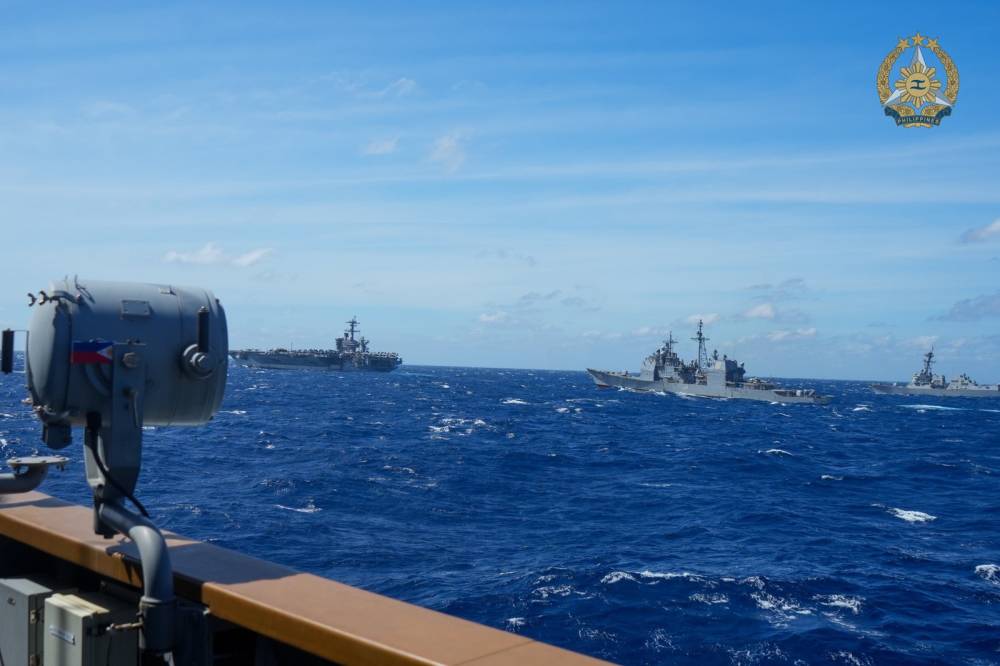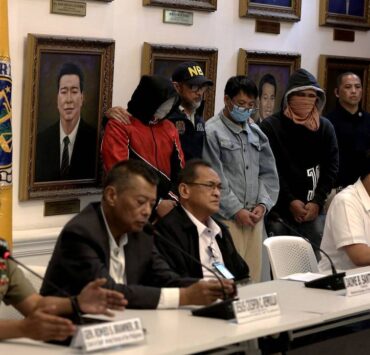Chinese Navy watches PH-US joint drills in WPS

Chinese Navy warships, including a high-tech surveillance vessel, kept watch at a distance while Philippine and US forces held their two-day joint drills in the West Philippine Sea (WPS), the Armed Forces of the Philippines said on Monday.
Manila and Washington carried out joint maritime exercises for the first time this year on Friday and Saturday off Palawan province. This saw the participation of nuclear-powered aircraft carrier USS Carl Vinson (CVN-70).
AFP spokesperson Col. Francel Margareth Padilla said they monitored five vessels from the People’s Liberation Army (PLA) Navy during the joint patrols or “maritime cooperative activity” (MCA)—including the Type 052B Luyang I-class destroyer, two Type 054A Jiangkai II-class frigates, a Type 055 Renhai-class cruiser, and a Type 815 Dongdiao-class spy ship.
“They maintained a distance and did not directly interfere with the MCA activities. We continuously monitored their movements to ensure the safety and security of our personnel and assets,” Padilla said in a statement.
“Our forces maintained constant communication and coordination throughout the activity, ensuring a safe and professional environment. We adhered to international law and established protocols for maritime interactions,” she said.
China’s PLA Southern Theater Command also claimed it held a maritime and air combat patrol in the South China Sea from Friday to Saturday, the same time during the Philippine-US exercises.
Guided-missile ships
For the two-day exercises, the Philippine Navy deployed the frigate BRP Antonio Luna (FF-151) and patrol ship BRP Andres Bonifacio (PS-17), while the Philippine Air Force dispatched two FA-50 light fighter aircraft and search and rescue assets.
The US Navy, meanwhile, sent a P-8A Poseidon of Task Force 72 alongside the Carrier Strike Group 1—which included the USS Carl Vinson, Ticonderoga-class guided-missile cruiser USS Princeton (CG-59) and Arleigh Burke-class guided-missile destroyers USS Sterett (DDG-104) and USS William P. Lawrence (DDG-110), an MH-60 Seahawk helicopter, a V-22 Osprey helicopter, and two F-18 Hornet fighter jets.
The two allies conducted a Communications Check Exercise, Division Tactics/Officer of the Watch maneuver, Photo Exercise and Dissimilar Aircraft Combat Training.
Senior officials from the AFP Western Command were invited aboard the USS Carl Vinson while in the West Philippine Sea to observe flight operations and engage with US Navy officials.
“Professional engagement with allies, partners, and friends in the region allows us to build upon our existing, strong relationships and continue to learn from each other,” Rear Adm. Michael Wosje, commander of Carrier Strike Group 1, said in a statement by the US 7th Fleet.
‘Monster’ still in EEZ
Up north in Zambales, the so-called “monster ship” of the Chinese coast guard, which was first monitored off Capones Island on Jan. 4, moved away from the coast on Sunday but continued its presence within the Philippines’ exclusive economic zone (EEZ). Another Chinese coast guard vessel approached closer to the province.
The gigantic China Coast Guard (CCG) 5901 was at 167 kilometers (90 nautical miles) off Zambales, while CCG 3304 moved 120 km (65 nautical miles), the Philippine Coast Guard (PCG) said on Sunday night.
According to Commodore Jay Tarriela, PCG spokesperson for the West Philippine Sea, the offshore patrol vessel BRP Gabriela Silang has been conducting hourly radio challenges to remind the Chinese crew that their operations within the Philippines’ EEZ breach the United Nations Convention on the Law of the Sea.
The official earlier said they had observed that Chinese patrols had come as close as 111 km (60 nautical miles) off Luzon’s coast.
“Their goal is to normalize such deployments, and if these actions go unnoticed and unchallenged, it will enable them to alter the existing status quo,” he said then.
CCG vessels have been keeping a constant presence in the West Philippine Sea—part of the South China Sea being claimed by the Philippines— to enforce Beijing’s excessive maritime and territorial claims.
A 2016 ruling by the Permanent Court of Arbitration voided Beijing’s sweeping claims to nearly the entire South China Sea, saying these had no basis under international law, a decision China rejects.





















